Topics
Category
Era
Lakewood Cemetery Memorial Chapel, Minneapolis
Lakewood Chapel exterior, ca. 1996. Photograph by BBS Architects I Engineers; used with the permission of BBS Architects I Engineers.
The Memorial Chapel at Lakewood Cemetery (3600 Hennepin Avenue) in Minneapolis is one of the few buildings that can claim to be modeled after two World Heritage Sites. Its exterior, designed by architect Harry Wild Jones, was inspired by the Hagia Sophia in Istanbul. Its interior was designed by J&R Lamb Studios of New York and drew inspiration from St. Mark’s Basilica in Venice.
In 1908, Lakewood Cemetery Association hired local architect Harry Wild Jones to design a chapel for its grounds. A graduate of the Massachusetts Institute of Technology, Jones had already designed buildings around the world in various styles. Because the chapel needed to house a crematorium and a columbarium (urn storage room), which were relatively new building types, Jones visited crematoria in five Western cities as part of his planning process.
Lakewood Association members took the fairly unusual approach of awarding a separate design contract for the building’s interior finishes. They chose J&R Lamb Studios, a decorative arts company that specialized in ecclesiastical architecture as well as furnishings, metalwork, stained glass, mosaic, and sculpture. The studio was headed by Charles R. Lamb, a well-known architect, city planner, and decorative designer. Its creative team included Ella Condie Lamb (Lamb’s wife), who was herself a highly accomplished designer of murals and mosaic tile installations.
Lamb recruited six skilled mosaic artisans from Italy to fabricate over ten million pieces of marble, colored stone, and glass for the chapel. These were placed on gummed cloth and brought to Minneapolis for installation, a process that took nearly three years. An arts journal later declared that Lamb’s work at Lakewood “shows quite conclusively that Byzantine vaulting and Byzantine decoration constitute the best treatment for a chapel.” Another writer described the chapel as having “the most perfect example of Byzantine mosaic art in the United States.” Credit for the project was variously ascribed to its architect (Jones) and its interior designer (Lamb). Although critics praised the work by Lamb Studios, they often overlooked Ella’s significant contribution. She did receive recognition, however, from the New York Herald, which in 1911 dubbed her “The Mistress of Mosaic.”
Jones based the architecture of the chapel on a Greek cross plan, modified at the crossing with transept-like extensions running north (and, later, south). At the center of the crossing is a floor panel that can be opened to lower a casket by hydraulic lift to the crematorium in the basement. The chapel is topped with a double dome consisting of an exterior structural roof and an interior decorative ceiling suspended approximately three feet below the exterior shell. As was the tradition with Byzantine architecture, the apse (the section behind the altar) is located on the east side of the building. Light from the clerestory windows in the dome streams across the colorful mosaics throughout the day, creating a shimmering and glowing effect described as “a sundial of masterful proportions.”
Every part of the building’s design is layered with symbolism. The dome rests on four arches sitting on a base that forms a square. The circle has historically been seen as a symbol of heaven, particularly when found in a dome; the square has traditionally represented earth. Combining the two symbolically creates a sacred space. The dome is decorated with twelve angel figures representing departing spirits. Four of the angels, located at the four points of the compass, hold red roses symbolizing the four corners of the earth.
The transition from the circular dome to the square floor area was completed with curved triangular wall sections at the four corners, known as pendentives. Here, the Lambs placed four circular mosaic portraits of seated women representing Faith, Hope, Memory, and Love. Mosaic geometric patterns adorn most of the other surfaces of the Chapel.
Because of the working crematorium in the basement, the architect opted for fire-safety reasons to use virtually no wood, nails, varnish or paint. The building exterior is constructed with pink ashlar granite layered in alternating widths, and features a red tile dome. Brick segmental arches support the interior floors and roof. There are virtually no flat ceilings in the building, as all horizontal surfaces are vaulted.
A 1996 renovation updated the chapel’s mechanical systems and added an expanded crematory designed by the architects Brooks Borg Skiles of Des Moines, Iowa. These additions are located below grade and covered with landscaping. The building, which can seat two hundred visitors, continues to be used for funeral and memorial services. It also hosts musical performances and other cultural activities for the general public.
Editor’s note: The writer of this entry thanks George F. Cook III (the great-grandson of the original contractor of the Lakewood Chapel, George Cook), Julie Carpenter, and the staff of Lakewood Cemetery for their assistance.
Bibliography
“Angels and the Outfield: How Minneapolis Architect Harry Wild Jones Brought Beauty to the Masses.” Lakewood News and Stories, August 30, 2019.
https://www.lakewoodcemetery.org/2019-08-30-angels-and-the-outfield-how-minneapolis-architect-harry-wild-jones-brought-beauty-to-th
Astakhova, E. “Architectural Symbolism in Tradition and Modernity.” Institute of Physics (IOP) Conference Series: Materials Science and Engineering 913 (2020).
https://iopscience.iop.org/article/10.1088/1757-899X/913/3/032024
Calter, Paul. Squaring the Circle: Geometry in Art & Architecture. Hoboken, NJ: Wiley, 2008.
⸻ . “The Circle, The Wheel of Fortune & The Rose.” Dartmouth College course curriculum, 1998.
https://math.dartmouth.edu/~matc/math5.geometry/unit9/unit9.html
J&R Lamb Studios.
https://lambstudios.com
Kudzia, Camille. Lakewood Memorial Chapel. National Register of Historic Places nomination file, February 1982. State Historic Preservation Office, St. Paul.
https://catalog.archives.gov/id/93201917
Lakewood Cemetery. “Art Styles, Sculptures, & Symbolism.” https://web.archive.org/web/20200921193836/https://www.lakewoodcemetery.org/styles-sculptures-symbolism
Lakewood Cemetery. Lakewood Memorial Chapel: A Visitor’s Guide. Undated.
https://www.lakewoodcemetery.org/wp-content/uploads/2021/02/LakewoodCemetery_MemorialChapel_Guide.pdf
Lethaby, W. R. Architecture, Mysticism and Myth. Mineola, NY: Dover Publications, 2004. Facsimile of 1892 edition.
https://archive.org/details/cu31924008729349/page/n3/mode/2up
Minneapolis Heritage Preservation Commission. Lakewood Memorial Chapel.
https://www2.minneapolismn.gov/resident-services/property-housing/landmarks/alphabetical/lakewood-memorial-chapel
Monardo, Clare Ave. "Lakewood Memorial Chapel." Archipedia, undated. Society of Architectural Historians (SAH).
http://sah-archipedia.org/buildings/MN-01-053-0047
Nelson, Tim. “Lakewood Cemetery’s Memorial Chapel Marks 100 Years.” Minnesota Public Radio, May 28, 2010.
https://minnesota.publicradio.org/features/2010/05/28-lakewood-cemetery
Osteen, Mame. Haven in the Heart of the City: The History of Lakewood Cemetery. Minneapolis: Lakewood Cemetery, 1992.
https://archive.org/details/haveninheartofci0000oste/page/n5/mode/2up
Seeley, Barea Lamb. Ella’s Certain Window: An Illustrated Biography of Ella Condie Lamb, An American Artist. United States: BLS Corporation, 1998.
https://archive.org/details/ellascertainwind0000seel/page/336/mode/2up
Vandam, Elizabeth A. Harry Wild Jones, American Architect. Minneapolis: Nodin Press, 2008.
Related Resources
Primary
Charles R. Lamb architectural drawings and papers, 1897–1911
Avery Drawings and Archives, Columbia University, New York
Description: Drawings and maps, with related clippings, showing proposals for traffic routes; railway and ship terminals; boulevards and streets; buildings; public spaces; bridges; and other projects, located mostly in Manhattan, with some in Brooklyn.
https://findingaids.library.columbia.edu/ead/nnc-a/ldpd_3460625
Charles R. Lamb scrapbook on the Dewey Arch, 1899–1901
Archives of American Art, Smithsonian, Washington, DC
Description: Scrapbook contains clippings concerning the construction and history of "Dewey Arch" in New York City, a monument designed by Lamb built to honor and welcome Admiral George Dewey upon his return from Manila Bay where Dewey destroyed the Spanish fleet, helping to end the Spanish-American War in 1898.
https://www.aaa.si.edu/collections/charles-r-lamb-scrapbook-dewey-arch-7833
Ella Condie Lamb artist file
National Portrait Gallery Library, Smithsonian Libraries, Washington, DC
Description: Folder(s) may include exhibition announcements, newspaper and/or magazine clippings, press releases, brochures, reviews, invitations, illustrations, resumes, artist's statements, exhibition catalogs.
https://www.sil.si.edu/DigitalCollections/art-design/artandartistfiles/vf_details.cfm?id=18886
Library of Congress. Lamb Studios Archive. https://www.loc.gov/collections/lamb-studio/about-this-collection
Photograph of Charles R. Lamb, 1917. Doris Ulmann Photographic Collection, University of Kentucky.
https://exploreuk.uky.edu/catalog/xt7xgx44rn22_3_104
Secondary
“Charles R. Lamb, An Architect, Dies.” New York Times, February 23, 1942.
“Ella Condie Lamb. Notes on a Recent Exhibition.” International Studio XLVI, no. 183 (May 1912), lxxxv–lxxvi.
https://digi.ub.uni-heidelberg.de/diglit/international_studio46/0429
Marke, G. Mortimer. “The Twenty-Seventh Annual Exhibition of the Architectural League of New York.” International Studio XLVI, no. 183 (May 1912), xiv–xviii.
https://digi.ub.uni-heidelberg.de/diglit/international_studio46/0409
“Mrs. Ella C. Lamb, Noted Artist, Dead.” New York Times, January 25, 1936.
Web
Twin Cities PBS. Remembering Place: A Cemetery Story. Air date November 11, 2021.
https://www.tpt.org/remembering-place
Related Audio
MN90: All That Glitters Is Gold
All rights reserved
More Information
Related Images
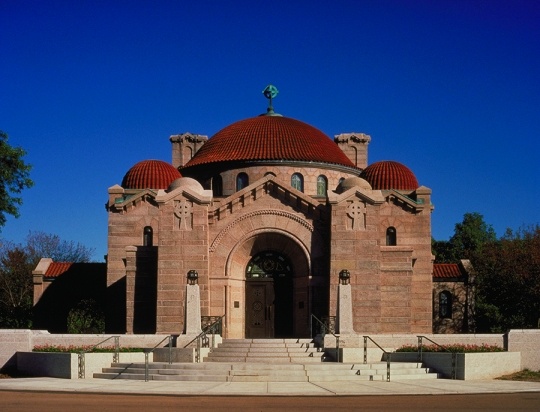
Lakewood Chapel exterior, ca. 1996
Lakewood Chapel exterior, ca. 1996. Photograph by BBS Architects I Engineers; used with the permission of BBS Architects I Engineers.
All rights reserved
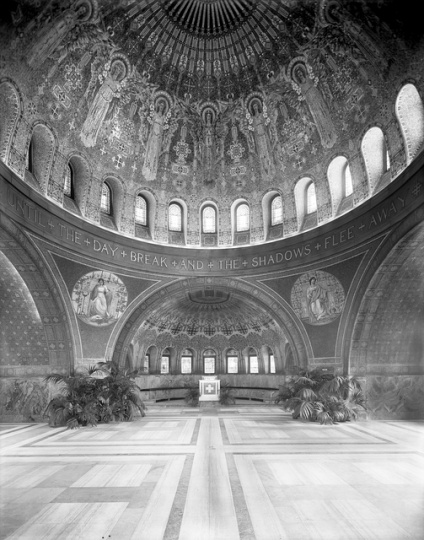
Lakewood Chapel dome interior, facing rear, ca. 1910
Holding Location
More Information
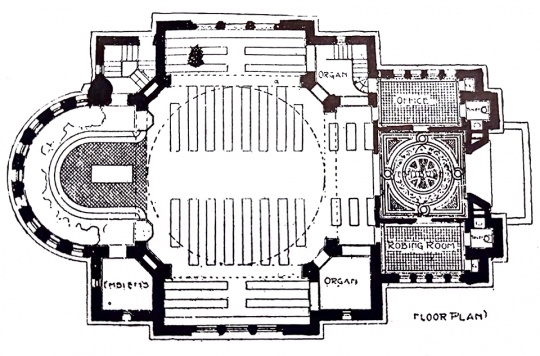
Lakewood Chapel floor plan
Public domain
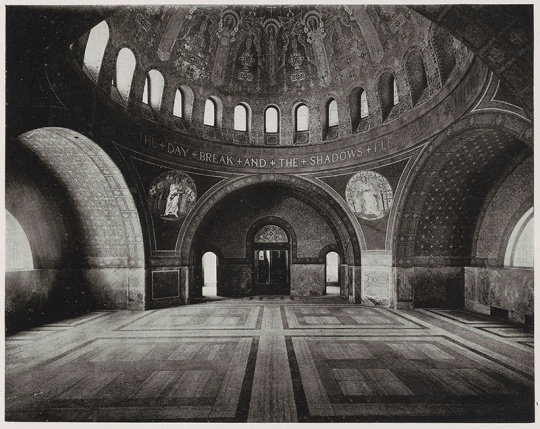
Lakewood Chapel dome interior, facing entrance
Public domain
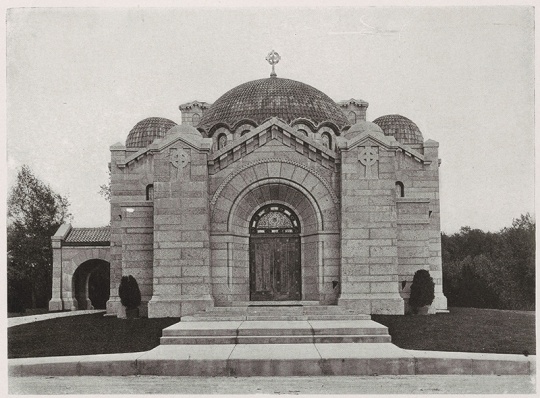
Lakewood Chapel front façade
Public domain
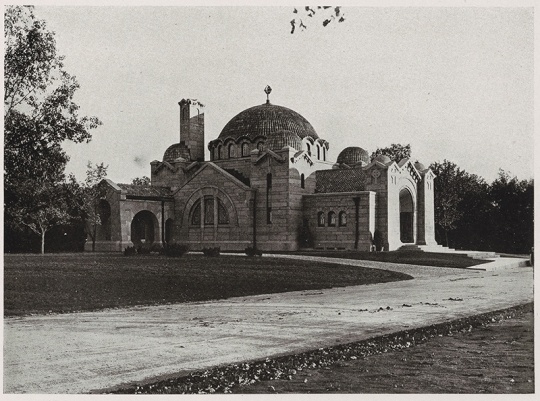
Lakewood Chapel rear façade
Public domain
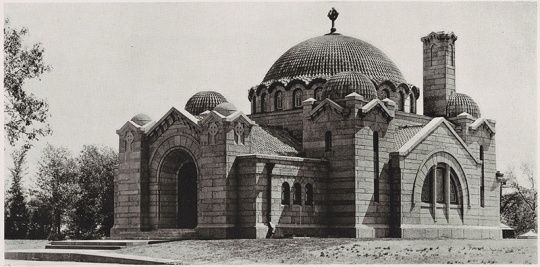
Lakewood Chapel front and side façade
Public domain

Mosaic inside Lakewood Chapel
Holding Location
More Information
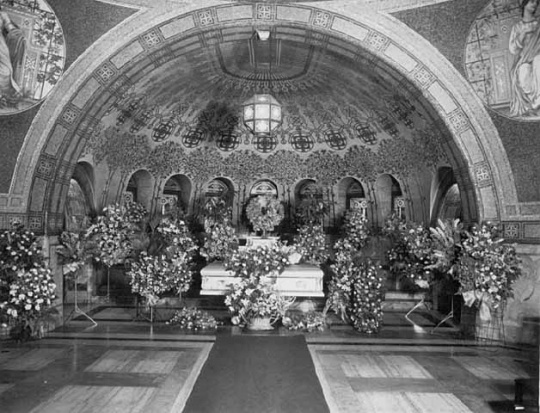
Funeral decorations inside Lakewood Chapel
Holding Location
More Information
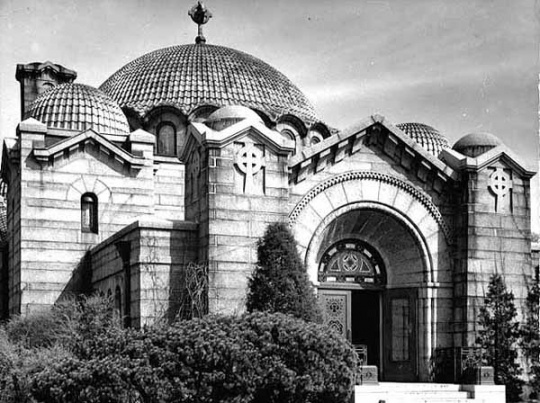
Lakewood Chapel exterior, ca. 1948
Holding Location
More Information
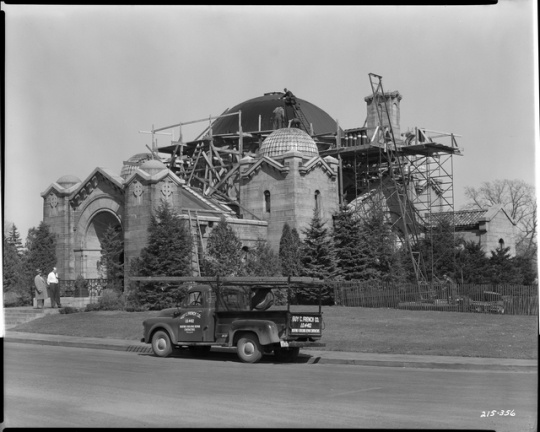
Repairing the roof of Lakewood Chapel
Holding Location
More Information
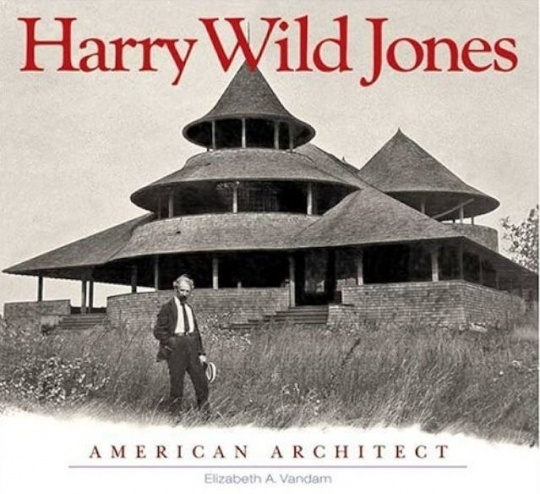
Harry Wild Jones: American Architect (book cover)
The cover of Harry Wild Jones: American Architect, by Elizabeth A. Vandam (Nodin Press, 2008). Used with the permission of Norton Stillman, John Toren, and Nodin Press.
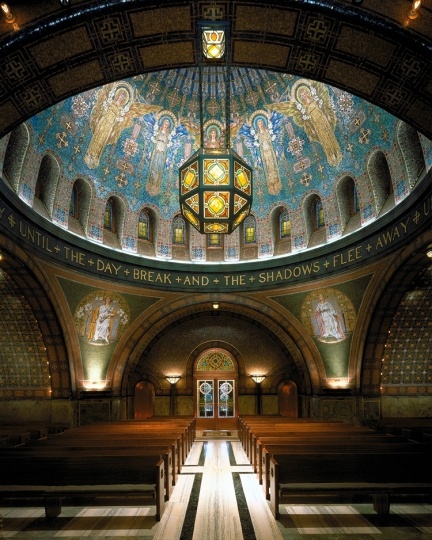
Dome and chandelier
The dome inside Lakewood Chapel showing the chandelier designed by Charles Lamb, ca. 1996. Photograph by BBS Architects I Engineers; used with the permission of BBS Architects I Engineers.
All rights reserved
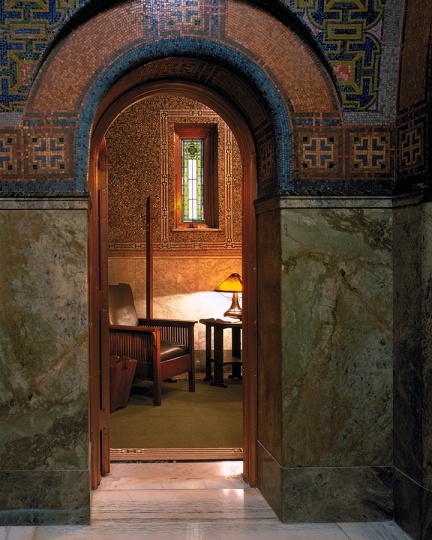
Lakewood Chapel arched doorway
An arched doorway inside Lakewood Chapel, ca. 1996. Photograph by BBS Architects I Engineers; used with the permission of BBS Architects I Engineers.
All rights reserved
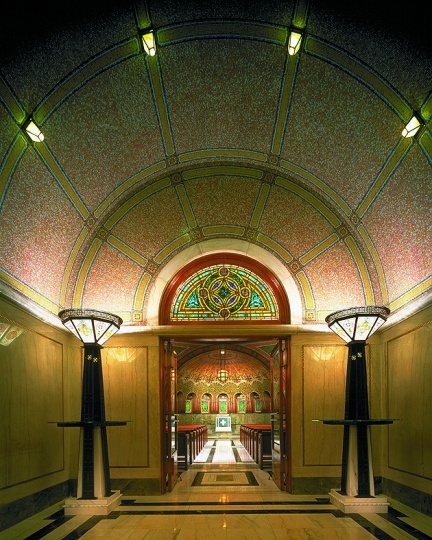
Lakewood Chapel lobby interior
The interior of the lobby in Lakewood Chapel, ca. 1996. Photograph by BBS Architects I Engineers; used with the permission of BBS Architects I Engineers.
All rights reserved
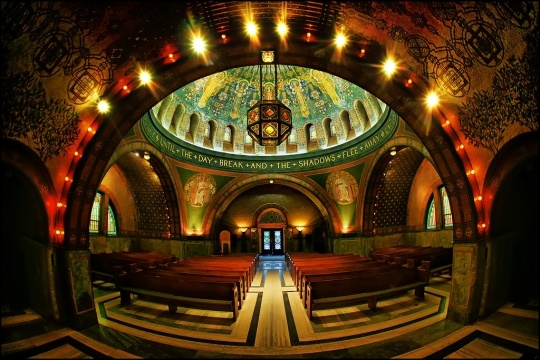
Illuminated interior of Lakewood Chapel
All rights reserved
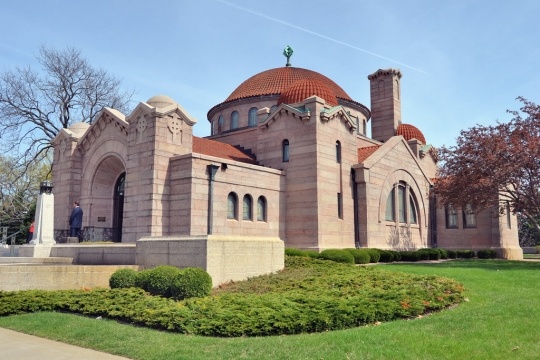
Lakewood Chapel exterior, 2012
Lakewood Chapel, April 4, 2012. Photograph by Jonathan Ellgen; used with the permission of Jonathan Ellgen.
All rights reserved
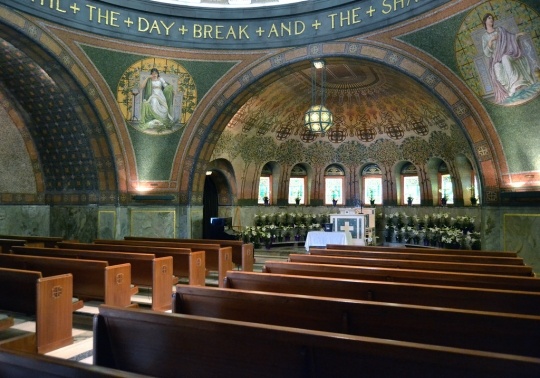
Lakewood Chapel dome interior, 2012
Lakewood Chapel dome interior, April 4, 2012. Photograph by Jonathan Ellgen; used with the permission of Jonathan Ellgen.
All rights reserved
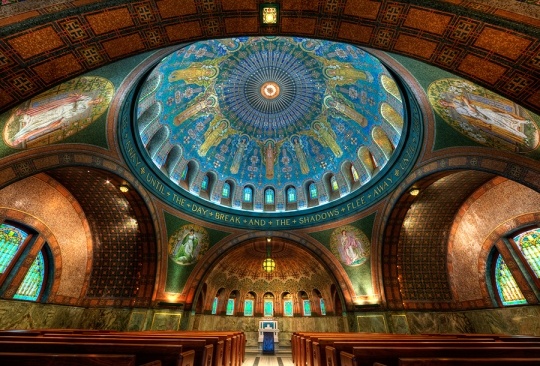
Lakewood Chapel dome interior, 2014
Lakewood Chapel interior, 2014. Photograph by Wayne Moran; used with the permission of Wayne Moran.
All rights reserved
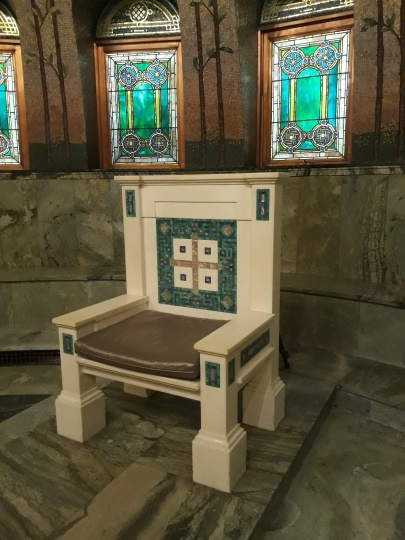
Chair inside Lakewood Chapel
All rights reserved
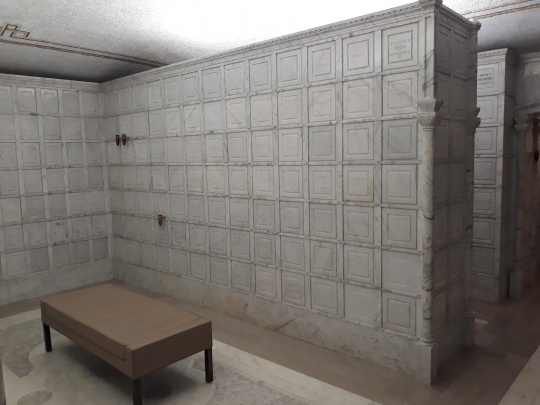
Columbarium in Lakewood Chapel
All rights reserved
Related Articles
Turning Point
The Lakewood Chapel Building Committee commissions the design services of local architect Harry Wild Jones for the chapel’s structure and exterior. Separately, it commissions J&R Lamb Studios, a national firm based in New York, for the interior decorative finishes. By bringing these two firms together by 1909, the committee creates a fruitful collaboration that maximizes the individual talents of Harry Wild Jones, Charles R. Lamb, and Ella Condie Lamb, and results in an extraordinary building.
Chronology
1857
1876
1883
1884
1888
1891
1906
1907
1908
1908
1909
1909
1910
1935
1996
Bibliography
“Angels and the Outfield: How Minneapolis Architect Harry Wild Jones Brought Beauty to the Masses.” Lakewood News and Stories, August 30, 2019.
https://www.lakewoodcemetery.org/2019-08-30-angels-and-the-outfield-how-minneapolis-architect-harry-wild-jones-brought-beauty-to-th
Astakhova, E. “Architectural Symbolism in Tradition and Modernity.” Institute of Physics (IOP) Conference Series: Materials Science and Engineering 913 (2020).
https://iopscience.iop.org/article/10.1088/1757-899X/913/3/032024
Calter, Paul. Squaring the Circle: Geometry in Art & Architecture. Hoboken, NJ: Wiley, 2008.
⸻ . “The Circle, The Wheel of Fortune & The Rose.” Dartmouth College course curriculum, 1998.
https://math.dartmouth.edu/~matc/math5.geometry/unit9/unit9.html
J&R Lamb Studios.
https://lambstudios.com
Kudzia, Camille. Lakewood Memorial Chapel. National Register of Historic Places nomination file, February 1982. State Historic Preservation Office, St. Paul.
https://catalog.archives.gov/id/93201917
Lakewood Cemetery. “Art Styles, Sculptures, & Symbolism.” https://web.archive.org/web/20200921193836/https://www.lakewoodcemetery.org/styles-sculptures-symbolism
Lakewood Cemetery. Lakewood Memorial Chapel: A Visitor’s Guide. Undated.
https://www.lakewoodcemetery.org/wp-content/uploads/2021/02/LakewoodCemetery_MemorialChapel_Guide.pdf
Lethaby, W. R. Architecture, Mysticism and Myth. Mineola, NY: Dover Publications, 2004. Facsimile of 1892 edition.
https://archive.org/details/cu31924008729349/page/n3/mode/2up
Minneapolis Heritage Preservation Commission. Lakewood Memorial Chapel.
https://www2.minneapolismn.gov/resident-services/property-housing/landmarks/alphabetical/lakewood-memorial-chapel
Monardo, Clare Ave. "Lakewood Memorial Chapel." Archipedia, undated. Society of Architectural Historians (SAH).
http://sah-archipedia.org/buildings/MN-01-053-0047
Nelson, Tim. “Lakewood Cemetery’s Memorial Chapel Marks 100 Years.” Minnesota Public Radio, May 28, 2010.
https://minnesota.publicradio.org/features/2010/05/28-lakewood-cemetery
Osteen, Mame. Haven in the Heart of the City: The History of Lakewood Cemetery. Minneapolis: Lakewood Cemetery, 1992.
https://archive.org/details/haveninheartofci0000oste/page/n5/mode/2up
Seeley, Barea Lamb. Ella’s Certain Window: An Illustrated Biography of Ella Condie Lamb, An American Artist. United States: BLS Corporation, 1998.
https://archive.org/details/ellascertainwind0000seel/page/336/mode/2up
Vandam, Elizabeth A. Harry Wild Jones, American Architect. Minneapolis: Nodin Press, 2008.
Related Resources
Primary
Charles R. Lamb architectural drawings and papers, 1897–1911
Avery Drawings and Archives, Columbia University, New York
Description: Drawings and maps, with related clippings, showing proposals for traffic routes; railway and ship terminals; boulevards and streets; buildings; public spaces; bridges; and other projects, located mostly in Manhattan, with some in Brooklyn.
https://findingaids.library.columbia.edu/ead/nnc-a/ldpd_3460625
Charles R. Lamb scrapbook on the Dewey Arch, 1899–1901
Archives of American Art, Smithsonian, Washington, DC
Description: Scrapbook contains clippings concerning the construction and history of "Dewey Arch" in New York City, a monument designed by Lamb built to honor and welcome Admiral George Dewey upon his return from Manila Bay where Dewey destroyed the Spanish fleet, helping to end the Spanish-American War in 1898.
https://www.aaa.si.edu/collections/charles-r-lamb-scrapbook-dewey-arch-7833
Ella Condie Lamb artist file
National Portrait Gallery Library, Smithsonian Libraries, Washington, DC
Description: Folder(s) may include exhibition announcements, newspaper and/or magazine clippings, press releases, brochures, reviews, invitations, illustrations, resumes, artist's statements, exhibition catalogs.
https://www.sil.si.edu/DigitalCollections/art-design/artandartistfiles/vf_details.cfm?id=18886
Library of Congress. Lamb Studios Archive. https://www.loc.gov/collections/lamb-studio/about-this-collection
Photograph of Charles R. Lamb, 1917. Doris Ulmann Photographic Collection, University of Kentucky.
https://exploreuk.uky.edu/catalog/xt7xgx44rn22_3_104
Secondary
“Charles R. Lamb, An Architect, Dies.” New York Times, February 23, 1942.
“Ella Condie Lamb. Notes on a Recent Exhibition.” International Studio XLVI, no. 183 (May 1912), lxxxv–lxxvi.
https://digi.ub.uni-heidelberg.de/diglit/international_studio46/0429
Marke, G. Mortimer. “The Twenty-Seventh Annual Exhibition of the Architectural League of New York.” International Studio XLVI, no. 183 (May 1912), xiv–xviii.
https://digi.ub.uni-heidelberg.de/diglit/international_studio46/0409
“Mrs. Ella C. Lamb, Noted Artist, Dead.” New York Times, January 25, 1936.
Web
Twin Cities PBS. Remembering Place: A Cemetery Story. Air date November 11, 2021.
https://www.tpt.org/remembering-place






















